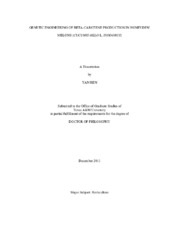| dc.description.abstract | Genetic transformation is a useful tool to incorporate novel genes, potentially allowing sexual incompatibility and interspecific barriers to be circumvented. The purpose of this study was to improve beta-carotene levels in melon fruits by transferring a phytoene synthase (PSY) gene. At present, there are not sufficient regeneration and transformation studies reported on two commercially important melon types - western shipper cantaloupe and honeydew. To establish a high efficiency shoot regeneration system, we evaluated three types of explants in our elite breeding lines. A shoot tip with a hypocotyl and cotyledon fragments, regenerated shoots whereas a shoot tip with a hypocotyl without cotyledon, did not produce regenerants. Murashige & Skoog (MS) basal medium with 1 mg 1⁻¹ benzyladenine (BA), 0.26 mg 1⁻¹ abscisic acid (ABA) and 0.8 mg 1⁻¹ indole-3-acetic acid (IAA) was the best for regeneration from cotyledon explants in cantaloupe 'F39'. MS basal medium with 1 mg 1⁻¹ BA and 0.26 mg 1⁻¹ ABA was chosen for honeydew '150' to solve a curving-up problem of explants. Fifty to sixty percent of regenerants were found to be polyploids. To establish a reliable Agrobacterium-mediated transformation protocol, kanamycin sensitivity as well as Timentin[trademark] and Clavamox® were evaluated. Kanamycin 200 and 150 mg 1⁻¹ were chosen as the threshold levels for 'F39' and '150' respectively. No significant differences were found between Timentin[trademark] and Clavamox® in 'F39'; however, Clavamox® reduced the incidence of vitrification and increased the frequency of shoot elongation in '150'. A. tumefaciens strain EHA105, harboring pCNL56 carrying nptII and gusA genes, was used to establish a transformation protocol. The transformation efficiency was 0.3% from 'F39' and 0.5% from '150'. We introduced a watermelon PSY-C gene under the control of a fruit-specific promoter of a polygalacturonase gene into '150'. All the transgenic plants were tetraploids based on flow cytometry assays. Up to 32-fold of beta-carotene was elevated in the rind tissue of transgenic honeydew including phytoene increase. This is a very promising result for a further investigation to increase beta-carotene level in flesh tissue using the PSY-C gene with an appropriate promoter. | en |


